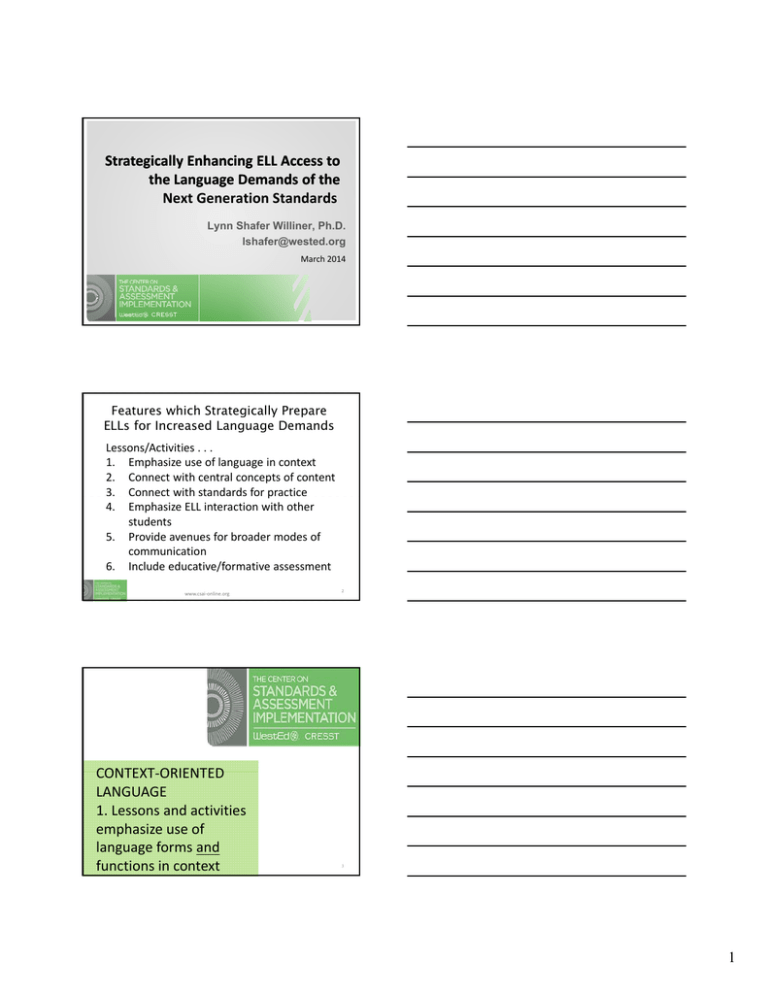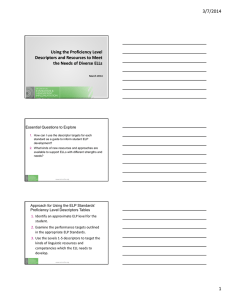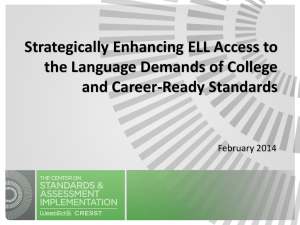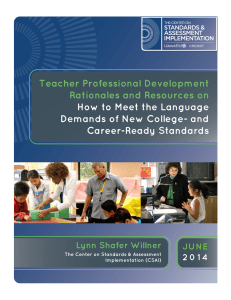Strategically Enhancing ELL Access to the Language Demands of the
advertisement

Strategically Enhancing ELL Access to the Language Demands of the Next Generation Standards Lynn Shafer Williner, Ph.D. lshafer@wested.org March 2014 Features which Strategically Prepare ELLs for Increased Language Demands Lessons/Activities . . . 1. Emphasize use of language in context 2. Connect with central concepts of content 3. Connect with standards for practice p 4. Emphasize ELL interaction with other students 5. Provide avenues for broader modes of communication 6. Include educative/formative assessment www.csai‐online.org CONTEXT‐ORIENTED CONTEXT ORIENTED LANGUAGE 1. Lessons and activities emphasize use of language forms and functions in context 2 3 1 Language Proficiency Had Been Configured as a Bridge to First Cross Before Approaching Content Previously Framed as a Sequential Relationship Now Framed as a Parallel Relationship Content ELP Content ELP standards and instruction provided a foundation from which to approach content standards ELP ELP standards and instruction reflect the language expectations contained in content standards www.csai‐online.org 4 ELL need more support than decontextualized vocabulary and grammar www.csai‐online.org Unpack Content Area Language Demands Using Text Analysis Approaches – Mary Schleppegrell, Univ. of Michigan Increase student reading comprehension, content-area understanding, and expository writing iti ability bilit b by examining i i ... • What a text is about • How a text is organized • How the author’s perspective is built into text 6 2 Schleppegrell Example: Analyze how definitions and explanations are constructed Cells divide in two steps. First, the nucleus of the cell divides, and then the cytoplasm divides. Mitosis is the process in which the nucleus di id to form divides f two identical id i l nuclei. l i Each E h new nucleus is also identical to the original nucleus. Mitosis is described as a series of phases or steps. The steps are named prophase, metaphase, anaphase, and telophase. … Schleppegrell Example: Focus on “Connectors” in Language Enlightenment Ideas Influence American Colonists Although a war had begun, the American colonists still debated their attachment to Great Britain. A growing p They y heard the number,, however,, favored independence. persuasive arguments of colonial leaders such as Patrick Henry, John Adams, and Benjamin Franklin. These leaders used Enlightenment ideas to justify independence. The colonists had asked for the same political rights as people in Britain, they said, but the king had stubbornly refused. Therefore, the colonists were justified in rebelling against a tyrant who had broken the social contract. Schleppegrell Example: Unpack Multiple Modalities in Mathematics Math symbols : a2 + (a + 2)2 = 340 Spoken language : “…and then you’ve got to add on the ‘a’ a squareds because of the brackets and the squareds, add up the ‘a’ squareds so you get two ‘a’ squareds plus your four ‘a’” Written language : The sum of the squares of two consecutive positive even integers is 340 (O’Halloran, 2000:384; 2003:196) 3 Use the Core Six Strategies to Unpack Text The Core Six include: • Reading for Meaning •Compare & Contrast • Inductive Learning • Circle of Knowledge Ci l f K l d • Write to Learn • Vocabulary's CODE The Core Six: Essential Strategies for Achieving Excellence with the Common Core. (2012). By Harvey F. Silver, R. Thomas Dewing, & Matthew J. Perini www.csai‐online.org Top Hat Organizers – The Core Six Similarities Differences Differences www.csai‐online.org 11 CENTRALIZED 2. Lessons and activities connect with core ideas and concepts in curriculum 12 4 Dramatically Higher Expectations ELA Math DOK1 25% 24% DOK2 38% 40% DOK3 26% 25% DOK4 11% 11% *Example based Smarter Balanced Specifications/Elementary Grades Courtesy: Herman (2013) www.csai‐online.org Increased Rigor Is Due to Added Cognitive and Academic Language Complexity Academic Language Complexity DOK an nd Cognitive Com mplexity Curriculum www.csai‐online.org Simple Language Demands at DOK1 Math – Recall, Draw, Define, List, Label . . . Courtesy: Herman (2013) www.csai‐online.org 5 Language Demands Increase Slightly at DOK2 Math – Simple Application Courtesy: Herman (2013) www.csai‐online.org At DOK3, ELL Need to Use Language to Draw Conclusions, Cite Evidence, Explain, Revise . . . Lookatthedrawing.Thenumbersalongsideeach columnandrowarethetotalofthevaluesofthe symbolswithineachcolumnandrow.What numbershouldreplacethequestionmark? (Webb et al., 2005) www.csai‐online.org Courtesy: Herman (2013) Much More Complex Language Demands at DOK4 Your class and your teacher are going on a field trip. There are three possible choices for the field trip: an aquarium, a science museum, or a zoo. Your teacher asked students to write down their first and second choices. In this task, you will determine where the class should go on the field trip based on the survey results and the cost per student student. • This is a map of your school and the three different field trip locations. • Here’s how students voted, first and second choice • Here are costs --in time, fees, transportation costs Analyze, recommend, justify www.csai‐online.org Courtesy: Herman (2013) 6 “Water up” the Curriculum (Edwin Ellis) Focus instruction on • Core Ideas • Critical details • [vs. Clarifying details] Similar to Backwards Design, first stage: • What is essential to know and be able to do? • What is important to know and do? • What is nice to know? What is worth being familiar with? Content Preview (August, 2011) 1. Focus students on important ideas in upcoming text by asking guiding questions • 2. specific to the text or use imagination and think beyond the text. Build background knowledge related to the text • 3. short video clips, visuals, readings in English or in L1 and questions thatt draw th d on students’ t d t ’ background b k d and/or d/ connectt to t related l t d texts/topics. Pre-teach content obligatory vocabulary • Tier II (general academic terms) or Tier III (high frequency domainspecific terms) 4. Create oral summary of text , then create written summary www.csai‐online.org Schleppegrell Example: Examining the Language of the Content Area 7 Lily Wong-Fillmore: Analyze “Juicy” Sentences Found in Complex Text A different way to think about text complexity… • Each day select text to amplify as part of instructional conversations. • Choose text that has complex structure but also that holds the essence of your lesson/activity, or some really pivotal information. Secondary teacher example of juicy sentence type of lesson http://indulgy.com/post/cW48ibBa1/goodlesson-for-making-juicy-sentences DEPTH 3. Lessons and activities are designed in relation to the Standards for Practice 23 Tool Created to Unpack the Language Practices Found in the CCSS and NGSS Google ELPD Framework to download this document. www.csai‐online.org 8 Strategy: Tie Instruction Related to Student Language Access to Use of the Practices “By explicitly calling attention to these practices, [analyses of the language demands of college and career-ready standards can be used to] cultivate higher order thinking skills in ELLs and target their ability to comprehend and communicate about complex text.” (CCSSO, ELPD Framework, 2012, p. 16). www.csai‐online.org The ELPD Framework provides us with a strategic choice about creating correspondences between ELP standards and CCR standards: Focus on Standards for Practice 9 Strategy: Design Language Lessons/Activities Around Instruction Involving These Practices EP2, EP5, MP3, EP4, SP7: Develop a strong base of e idence to base of evidence to support arguments, claims, or statements. www.csai‐online.org 10 Strategy: Design Language Lessons/Activities Around Instruction Involving These Practices SP2, MP4, SP5: Develop and use models with mathematical, scientific, and/or computational thinking www.csai‐online.org Strategy: Design Language Lessons/Activities Around Instruction Involving These Practices SP8, EP2: Take information, evaluate it, and be able to clearly and effectively communicate an appropriate response. www.csai‐online.org Strategy: Design Language Lessons/Activities Around Instruction Involving These Practices EP7, MP5: Appropriately and strategically use g y technology and visual media. www.csai‐online.org 11 Strategy: Design Language Lessons/Activities Around Instruction Involving These Practices MP1, MP2, MP6, MP7, MP8: Use problem g g solving strategies involving problem definition, modeling, precision, and regularity of reasoning. www.csai‐online.org Strategy: Design Language Lessons/Activities Around Instruction Involving These Practices SP1, SP3, SP4, SP6: After defining a problem and completing p g investigations, analyze data, construct explanations, and design solutions. www.csai‐online.org Strategy: Design Language Lessons/Activities Around Instruction Involving These Practices EP4, EP5, EP6: Participate in classroom discourse around a wide range of topics and texts (including complex texts), coming to understand other perspectives and cultures. www.csai‐online.org 12 Language Access Demands of the Common Core (Bunch, Kibler, & Pimentel, 2013) • Engage with complex texts to build knowledge across the curriculum • Use evidence to inform, argue, and analyze • W Workk collaboratively, ll b ti l understanding d t di multiple lti l perspectives, and presenting ideas • Use and develop linguistic resources to do all of the above (e.g., vocabulary, grammatical structures, and coherent and connected discourse) www.csai‐online.org The New ELP Standards Emphasize Embedded Use Key Functions Found in the Common Core/NGSS 1 construct meaning from oral presentations and literary and informational text through grade‐appropriate listening, reading, and viewing 2 participate in grade‐appropriate oral and written exchanges of information, ideas, and analyses, responding to peer, audience, or reader comments and questions 3 speak and write about grade‐appropriate complex literary and informational texts and topics construct grade‐appropriate oral and written claims and support them with reasoning and evidence conduct research and evaluate and communicate findings to answer questions or solve problems 4 5 6 7 8 9 10 analyze and critique the arguments of others orally and in writing adapt language choices to purpose, task, and audience when speaking and writing determine the meaning of words and phrases in oral presentations and literary and informational text create clear and coherent grade‐appropriate speech and text make accurate use of standard English to communicate in grade‐appropriate speech and www.csai‐online.org writing Connect to Rubrics Rating the Quality of the Content Area Lessons: EQuiP Rubrics EQUiP Rubric 13 http://aldnetwork.org/page/exemplar‐units‐lesson‐plans‐and‐tools Academic Language Development Network Lesson Plan Toolkit See Zwiers, O’Hara, & Pritchard (in press) Common Core Standards in diverse classrooms: Essential practices for developing academic language and disciplinary literacy. Stenhouse Publishers. INTERACTIVE 4. Lessons and activities which require ELL to interact and collaborate with others 42 14 Emphasis on Interaction and Collaboration • Two‐way interactive communication involving negotiation of meaning and developing proficiency in socio‐ developing proficiency in socio cultural aspects of English • Successful instructed language learning also requires opportunities for output (Ellis, 2008) www.csai‐online.org Anita Archer’s Graphic Organizers •Strategies for improving comprehension before, during, and after reading. http://miblsi.cenmi.org/MiBLSiModel/Implementation/ElementaryS chools/TierISupports/ArcherHandouts.aspx •Active Participation Instruction, Modeling and guided practice are used to teach students class participation strategies and behaviors. http://www.iu17.org/best‐practices/best‐practices‐videos/anita‐ archer‐strategies‐engagement‐videos/ http://www.scoe.org/pub/htdocs/archer‐videos.html www.csai‐online.org North Carolina DPI ENGLISH LANGUAGE ARTS AND MATH GRAPHIC ORGANIZERS http://www.ncpublicschools.org/acre/standards/commoncore-tools/#gomath English Language Arts Graphic Organizers •Argument •Compare C and dC Contrast t t •Dialectic Response •Inquiry Math Graphic Organizers •Synthesizing •Number Lines in the Common Core •Vocabulary www.csai‐online.org 15 http://aldnetwork.org/page/exemplar‐units‐lesson‐plans‐and‐tools Academic Language Development Network Lesson Plan Toolkit - 7th Grade Math Toolkit www.csai‐online.org Academic Language Development Network Lesson Plan Toolkit - 7th Grade Math Toolkit www.csai‐online.org 16 EQUITY/ACCESS 5. Lessons and activities provide avenues for broader modes of communication 49 Broader Communicative Modes to Support and Enhance ELL Potential to Learn •Even though ELL will produce language that includes features that distinguish them from their native‐English‐speaking peers, “it is possible [for ELs] to achieve the standards for college‐and‐ career readiness” (NGA Center & CCSSO, 2010b, p. 1). •ELL have the same potential as native speakers of English to engage in cognitively complex tasks. •Regardless of ELP level, all ELLs need access to challenging, grade‐appropriate curriculum, instruction, and assessment and benefit from activities requiring them to create linguistic output (Ellis, 2008a; 2008b). www.csai‐online.org Broader Interpretation of Communication Receptive modalities Listening and reading Productive modalities Speaking and writing www.csai‐online.org 17 Some people STILL think of UDL as a technology initiative or just for students with disabilities or intensive support needs. http://udlcenter.org/ UDL is framework for proactively designing learning experiences – from the beginning – that address grade level standards in ways that enable all students to gain knowledge, skills, and enthusiasm for learning. http://udlcenter.org/ Goals Firm Goals, Flexible Means • Clearly identified • Do NOT embed the means unnecessarily • Allow multiple paths to achievement http://udlcenter.org/ 18 Principles of UDL UDL calls for ... Multiple means of representation, to give learners various ways of acquiring information and knowledge Multiple means of expression, to provide learners alternatives for demonstrating what they know Multiple means of engagement, to tap into learners' interests, offer appropriate challenges, and increase motivation. http://udlcenter.org 55 / Differentiating Instruction (Flanagan, Liebling, & Meltzer, 2013) 19 EDUCATIVE ASSESSMENT 6. Lessons and activities include formative assessment 58 Formative Assessment in NOT… A test or instrument More frequent use of tests A score A one‐time event A one‐time event Something that happens at the end of a period of learning Something only teachers do Margaret Heritage(2013) www.csai‐online.org Educative Assessment (Wiggins) •The use of assessment tasks with real-work implications •The use of real models of performance •The use of on-going feedback and guidance from the instructor including negotiated criteria instructor, •The use of objective, independent assessment criteria •The use of on-going, recursive opportunities for learners to improve their performances (Wiggins, 1998) www.csai‐online.org 20 Using Formative Assessment with ELLs Assessment/Audit Question: “At what ELP level is the ELL performing?” Question that uses assessment to inform instruction: “Based on the targets outlined for the end of each ELP levels, what resources and competencies will the ELL need to develop?” www.csai‐online.org Four questions which serve as a starting point for any PLC: Dufour and Marzano offer the following: • What is it we want our students to know? g • How will we know if theyy are learning? • How will we respond when individual students do not learn? • How will we enrich and extend the learning for students who are proficient? www.csai‐online.org Intersecting Conversations around Improvement of Instructional Design Use of Formative/ Educative Assessment Use of Professional Learning Communities Improved Data Literacy www.csai‐online.org 21 Features which Strategically Prepare ELL for Increased Language Demands Lessons/Activities . . . 1. Emphasize use of language in context 2. Connect with central concepts of content 3. Connect with standards for practice p 4. Emphasize ELL interaction with other students 5. Provide avenues for broader modes of communication 6. Include educative/formative assessment www.csai‐online.org 64 Strategically Enhancing ELL Access to the Language Demands of the Next Generation Standards Lynn nn Shafer er Willner, Ph.D.. lshafer@wested.orgested.org March 2014 22


